19.62.050 Internal pedestrian access and design.
A. Purpose.
1. To improve the pedestrian and bicycling environment by making it easier, safer, and more comfortable to walk or ride among residences, to businesses, to the street sidewalk, to transit stops, through parking lots, to adjacent properties, and connections throughout the city.
2. To enhance access to on- and off-site open space areas and pedestrian/bicycle paths.
B. Access to Sidewalk. All buildings must feature pedestrian connections to a sidewalk per applicable block frontage standards in Chapter 19.61. See subsection (D) below for access design requirements.

|
C. Internal Circulation.
1. For sites with multiple buildings in the C, CBD, and MMU zones, pedestrian paths connecting businesses and residential entries on the same development site must be provided. Routes that minimize walking distances must be utilized to the extent practical.
DEPARTURES will be allowed where an indirect route would enhance the design and/or use of a common usable open space. See subsection (D) below for pathway design standards.
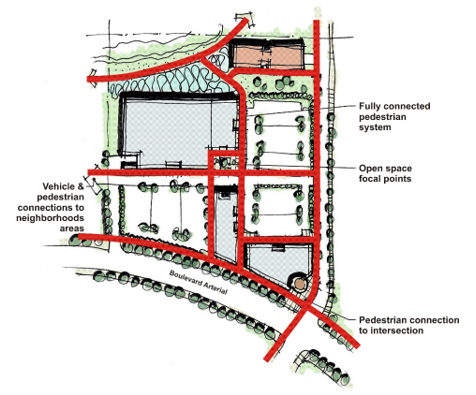
|
2. Sites with Residential Units. Provide direct pedestrian access between all ground related unit entries and a public street or to a clearly marked pathway network or open space that has direct access to a public street. Residential developments must provide a pedestrian circulation network that connects all main entrances on the site to other areas of the site, such as:
a. Parking areas.
b. Recreational areas.
c. Common outdoor areas.
d. Any pedestrian amenities.
For townhouses or other residential units fronting the street, the sidewalk may be used to meet this standard.
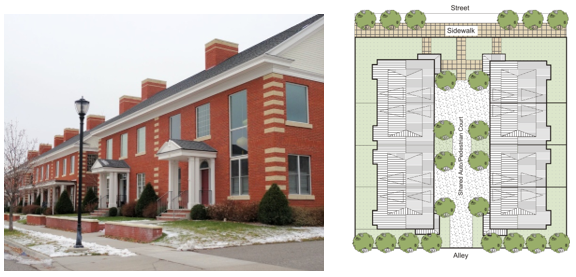
The entries of the example on the left connect directly to a public sidewalk while the entries in the right example connect to a common path that extends to the sidewalk. |
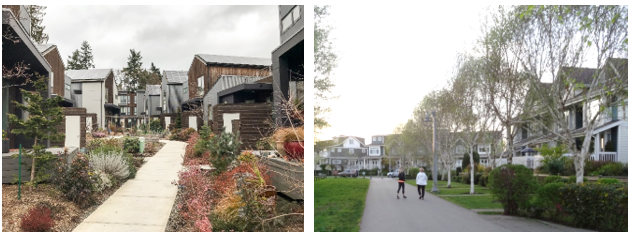
|
3. Crosswalks are required when a pathway crosses an on-site paved area accessible to vehicles. Crosswalks must contain contrasting material (such as concrete) and/or patterns (such as stamped asphalt), excluding painted surfaces.
4. Pedestrian Paths through Parking Lots. Large parking areas must include specially marked or paved sidewalks. At least one pathway must be provided every four rows of parking, or at a maximum spacing of 200 feet. The pathways must provide a safe connection to the building entrance and meet the pathway design standards in subsection D of this section. See examples below.

Note the location of the parking lot pathway in the upper right example (connecting shops in one building to the main entry of a grocery store). 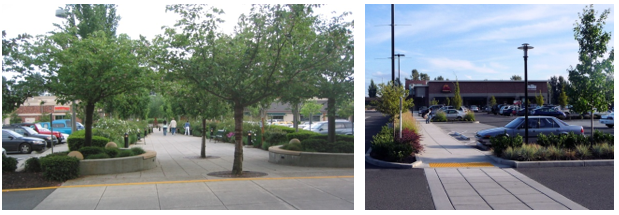
Note in both examples that the concrete pathway extends into the vehicular area to provide a highly visible and safe crosswalk. |
5. Barriers that limit future pedestrian access are prohibited. Gates that limit access to employees and residents are permitted. See subsection (D) below for pathway design standards.
D. Pathway Design.
1. All internal pedestrian pathways must have at least a minimum five-foot-wide unobstructed walking surface, except where otherwise required by the Anacortes engineering design standards.
2. All internal pedestrian pathways must be curbed and raised six inches above adjacent parking lot surface. Curbs may be cut to allow surface water runoff to enter low-impact development best management practices (LID BMPs). Ramps and other accessibility features must be provided in accordance with the Americans with Disabilities Act of 1990 and the current ADA Standards for Accessible Design.
DEPARTURE: Alternative curbless designs may be approved where design features are included to make the pathways safe and welcoming while enhancing the visual character of the site. See the lower right example in Figure 19.62.060(C) as a good example of a curbless design.
3. Where a pedestrian pathway is adjacent to perpendicular or angled parking, an extra two feet of pathway width must be provided to accommodate parked vehicles overhanging the pathway unless wheel stops are installed to prevent parked vehicles from overhanging the curb.
4. Pedestrian walks must be separated from structures with at least three feet of landscaping except where the adjacent building facade meets the storefront block frontage standards per AMC 19.61.060.
DEPARTURE: Other landscaping and/or facade design treatments to provide attractive pathways will be considered. Examples include sculptural, mosaic, bas-relief artwork, or other decorative treatments that meet the purpose. Figure 19.62.050(D)(4) below provides one example.

Internal pathways adjacent to building walls that do not meet storefront facade standards must provide at least three feet of landscaping to enhance the character of the pathway. The Director will consider alternative treatments, such as decorative walls (right example). |
5. Pathways along facades containing primary tenant entries of multi-tenant commercial or mixed-use buildings, and which are 100 feet long or more and abut parking lots, must include the following:
a. Twelve-foot-wide sidewalk and eight feet minimum unobstructed width.
b. Trees, as approved by the reviewing authority, placed at an average of 50 feet on center and placed in grates or in planting strips as established in subsection (D)(5)(c) of this section.
DEPARTURE: Breaks in the tree coverage will be allowed near major building entries to enhance visibility.
c. Planting strips with trees may be used between any vehicle access or parking area and the pathway; provided, that the trees required in subsection (D)(5)(b) of this section are included, the pathway meets the applicable width standards herein, and the combined pathway and planting strip is at least 12 feet wide. Stormwater best management practices elements may be included in the planting strip.
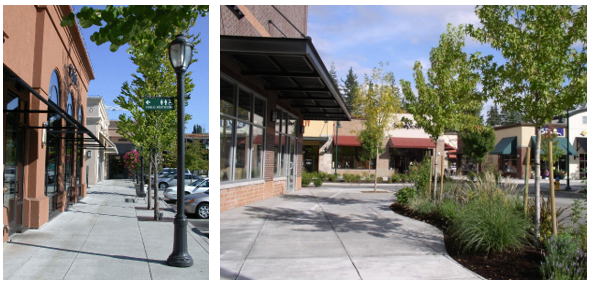
|
e. See also AMC 19.62.060(C), Internal Roadway Design. (Ord. 3040 § 2 (Att. A), 2019)